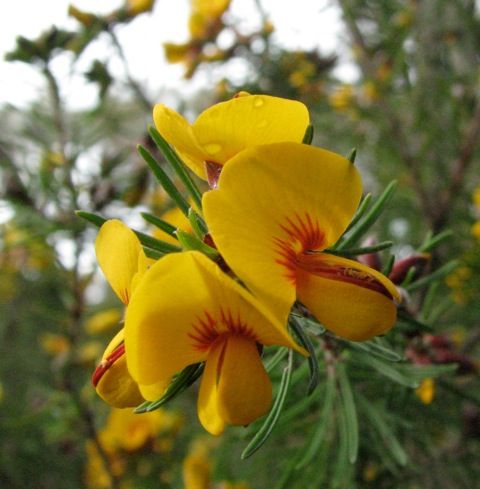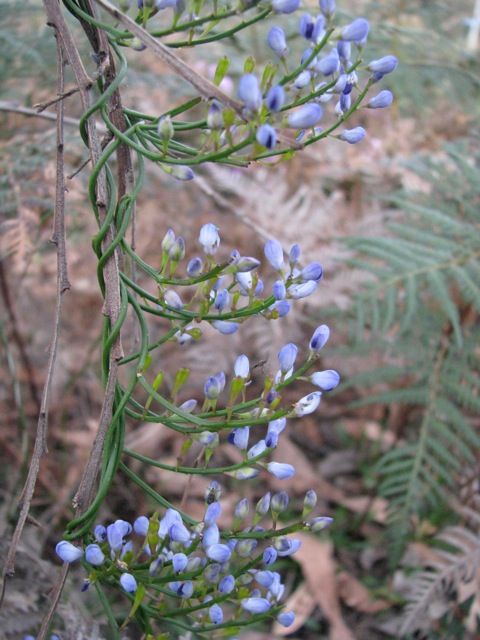It is so exciting seeing our wonderful spring flowering after all the rain … maybe our best spring ever!
With so many plants in flower to identify I suggest you take Flowers of Anglesea and Aireys Inlet on your walks, and I will concentrate on some of the common peas or ‘egg and bacon’ plants, as these can be really confusing. My challenge is the Parrot-peas or Dillwynias. These can be distinguished from other peas by the ‘wingier’ look of their two back petals. There are three main ones to look for this month.
Grey Parrot-pea, Dillwynia cinerascens and Showy Parrot-pea Dillwynia sericea subsp. 1 are difficult to tell apart as both have short, narrow leaves and the flowers mostly cluster near the stem.

Showy Parrot-pea
Grey Parrot-pea leaves are slender and turn back at the tip. The leaves of the Showy Parrot-pea are stiff and taper gradually to a point. I find it useful to run plants through my fingers as the Showy often feel coarser. The flowers can vary in colour from yellow to red.

Showy Parrot-pea
I really like Red Parrot-pea Dillwynia hispida which is less common, but wherever you find it there will be many others nearby. It has rich red petals which dangle attractively on fine wiry stems near the end of branches.

Red Parrot-pea
We have many species of Bush-peas or Pulteneas which can be recognised by their hooded look. Soft Bush-pea Pultenaea mollis grows to 3 metres, the flowers are bright yellow, and the leaves are long and narrow with inrolled margins. I have chosen this as my sensory plant of the month as I enjoy running the soft leaves through my hands.

Soft Bush-pea
Rough Bush-pea Pultenaea scabra also has yellow flowers, but only grows to about 1.5 metres. I always appreciate the ease of identification of this plant due to the small, heart-shaped leaves.

Rough Bush-pea
One of my favourite pea flowers is Daviesia brevifolia Leafless Bitter-pea. This unappealing, stiff, leafless spiky bush has been springing into flower at the end of winter with delightful, vivid apricot to salmon-pink flowers.

Leafless Bitter-pea
So what a about blue peas? Common Hovea Hovea heterophylla a low, spreading plant has been providing soft colour and interest during August.

Common Hovea
I will be on the lookout for the tiny, beautiful flowers of Love Creeper Comosperma volubile, which twines loosely up and around vegetation. I just wish I could get it to grow in my garden.

Love Creeper
To finish I wish to highlight our wonderful Common Heath Epacris impressa whose showy flowers have been brightening up our bush over the dull winter months.

Common Heath
It is the floral emblem of Victoria and occurs over much of Victoria, parts of South Australia, Tasmania and southern New South Wales, but is under threat in many areas. Recent research printed in Muellerina published by the Royal Botanic Gardens, has shown that the genetic structure of the whole of the species is diverse and healthy, with the most diverse being the population of the Otway region. Research is currently being undertaken to find out if differences in pollinators affects flowering times and flower colours.

Common Heath
Ref: Melanie Conomikes, Gregory M Moore, Cassandra Mc Lean Genetic analysis suggests a wide regional provenance distribution for Epacris impressa (Ericaceae).
Ellinor Campbell